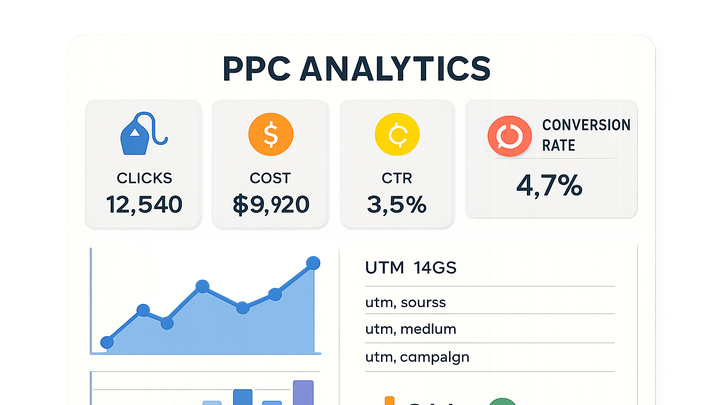Published on 2025-06-26T05:15:49Z
What is Pay-Per-Click (PPC)? Examples in Analytics
Pay-Per-Click (PPC) is a digital advertising model where advertisers pay a fee each time their ad is clicked. It enables precise budgeting and performance tracking by linking ad spend directly to user interactions. PPC campaigns can be monitored using analytics platforms—such as Google Analytics 4 (GA4) for comprehensive, event-based insights, or PlainSignal for privacy-focused, cookie-free measurement. Through structured tracking (UTM parameters, attribution models) these tools help marketers optimize keyword bids, ad creatives, and landing pages to maximize ROI. Integrating PPC data into analytics workflows reveals user behavior patterns, conversion paths, and the overall effectiveness of paid advertising efforts.
Pay-per-click (ppc)
PPC is a model where advertisers pay per ad click; performance is tracked and optimized using analytics tools like GA4 and PlainSignal.
Understanding Pay-Per-Click (PPC)
Pay-Per-Click (PPC) is a digital advertising approach where advertisers pay only when a user clicks on their ad. It provides clear cost attribution and enables granular budget control.
-
Definition of ppc
PPC is an online marketing model in which advertisers bid on keywords and pay a fee each time their ad is selected by a user.
-
Core metrics
Key metrics in PPC include clicks, impressions, cost, and click-through rate (CTR). Monitoring these helps evaluate campaign health.
-
Clicks
The number of times users click on an ad.
-
Impressions
How often an ad is displayed.
-
Cost
Total spend based on clicks (CPC × Clicks).
-
Click-through rate (ctr)
Ratio of clicks to impressions, expressed as a percentage.
-
Measuring PPC in Analytics
Analytics platforms translate PPC interactions into actionable data—tracking ad clicks, attributing conversions, and enabling ROI analysis.
-
Utm parameters and campaign tracking
UTM tags are URL parameters that help analytics tools identify the source, medium, and campaign of inbound traffic.
-
Utm_source
Identifies the ad platform (e.g., google, bing).
-
Utm_medium
Specifies the marketing medium (e.g., cpc).
-
Utm_campaign
Names the specific campaign.
-
Utm_term
Tracks paid keywords.
-
Utm_content
Differentiates ad creatives.
-
-
Attribution models
Attribution models assign credit for conversions across touchpoints, influencing budget allocation.
-
First-click attribution
Credits the first interaction.
-
Last-click attribution
Credits the final interaction before conversion.
-
Data-driven attribution
Uses machine learning to assign credit across the conversion path.
-
Example: PlainSignal PPC Tracking
PlainSignal offers cookie-free, privacy-first analytics ideal for tracking PPC clicks without third-party cookies.
-
Setup and configuration
Add PlainSignal’s script and preconnect tag to your HTML to start collecting PPC click data.
-
Add preconnect tag
Place
<link rel="preconnect" href="//eu.plainsignal.com/" crossorigin />in the <head> section. -
Include analytics script
Insert
<script defer data-do="yourwebsitedomain.com" data-id="0GQV1xmtzQQ" data-api="//eu.plainsignal.com" src="//cdn.plainsignal.com/plainsignal-min.js"></script>after the preconnect tag.
-
-
Tracking ppc clicks
PlainSignal automatically captures clicks on UTM-tagged links by reading the data-do attribute.
Example: Google Analytics 4 (GA4) PPC Tracking
GA4 provides robust event-based tracking and integrations with Google Ads for end-to-end PPC analysis.
-
Configure GA4 tag
Install the GA4 configuration tag using Google Tag Manager or gtag.js.
-
Gtm setup
Create a GA4 Configuration tag in Google Tag Manager and publish the container.
-
-
Enable advertising features
Activate Google signals and advertising reporting features to enrich PPC insights.
-
Import cost data
Link your Google Ads account to GA4 to automatically import campaign cost and click metrics.
Best Practices for PPC Analytics
Use data-driven insights to refine your PPC strategy, improve quality scores, and maximize ROI.
-
Optimize bidding strategies
Test automated bidding vs. manual bid adjustments based on cost per acquisition goals.
-
Monitor quality score
Enhance ad relevance, landing page experience, and expected CTR to lower CPC.
-
Analyze conversion paths
Examine user journeys across multiple touchpoints to allocate budget effectively.
-
A/b test ad creatives
Experiment with headlines, descriptions, and CTAs to improve click performance.
